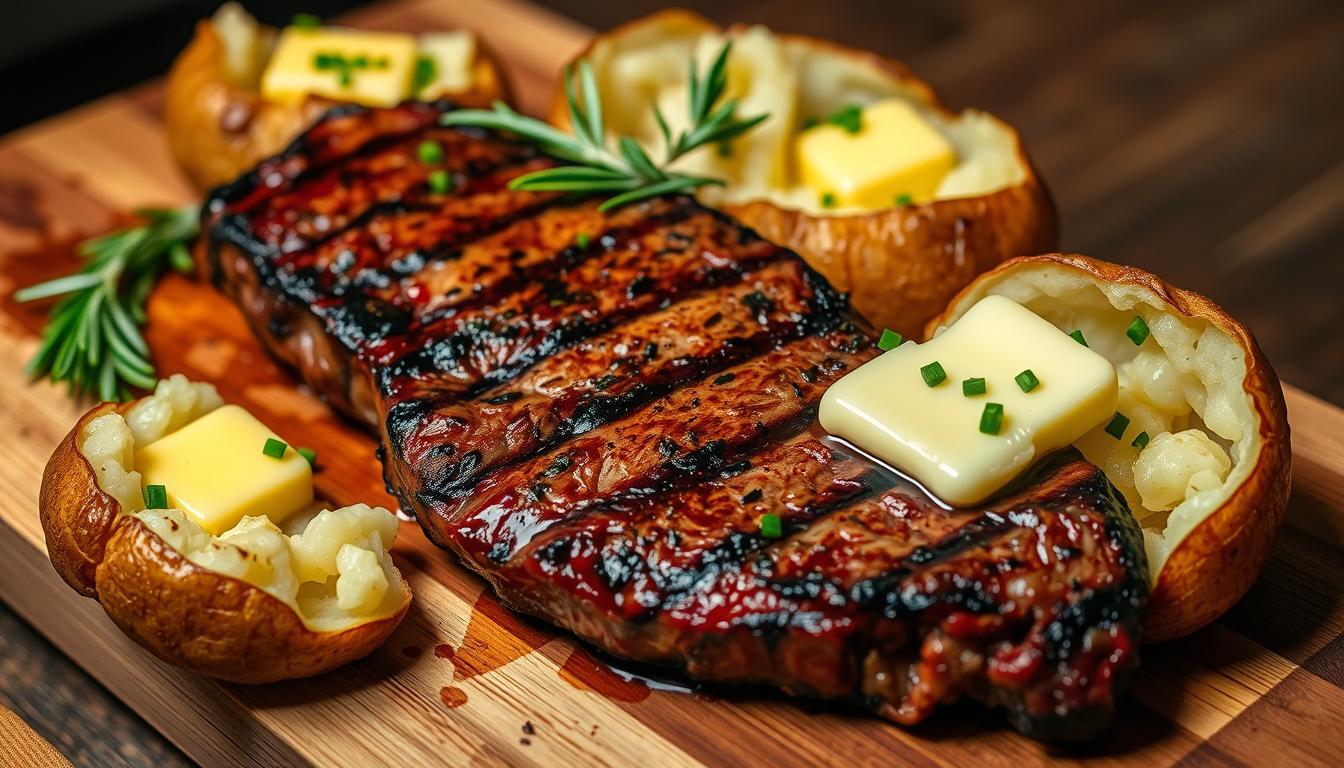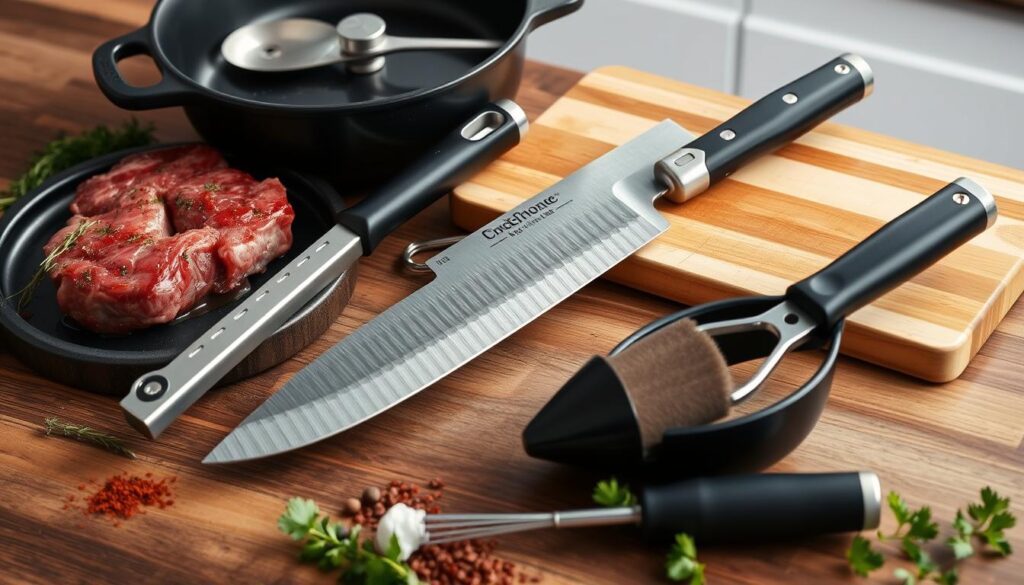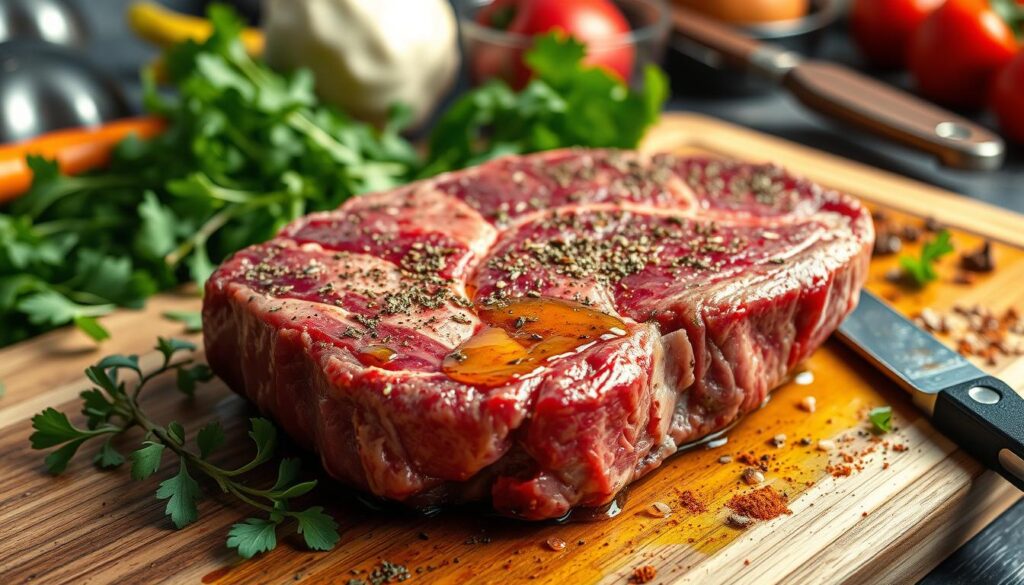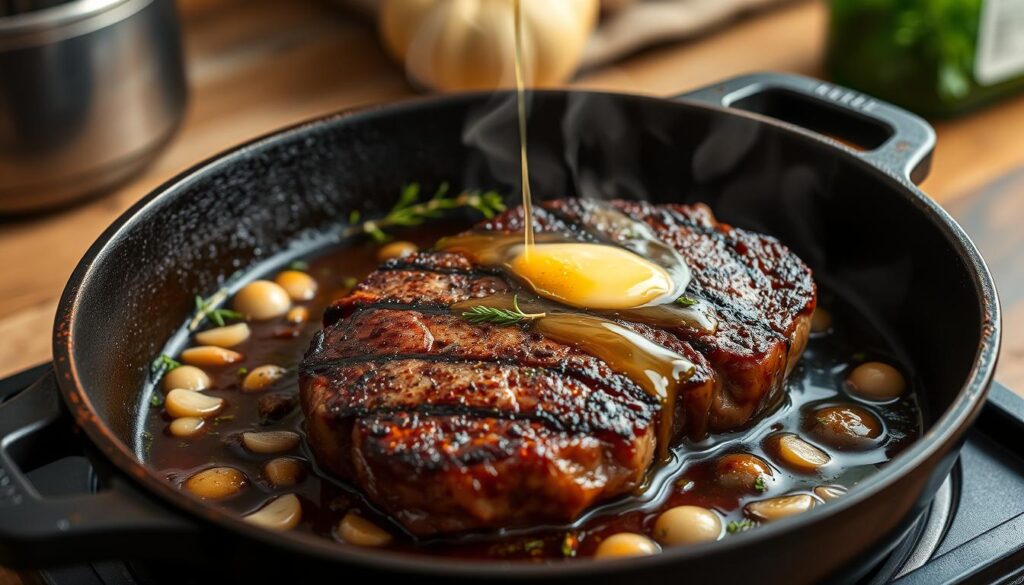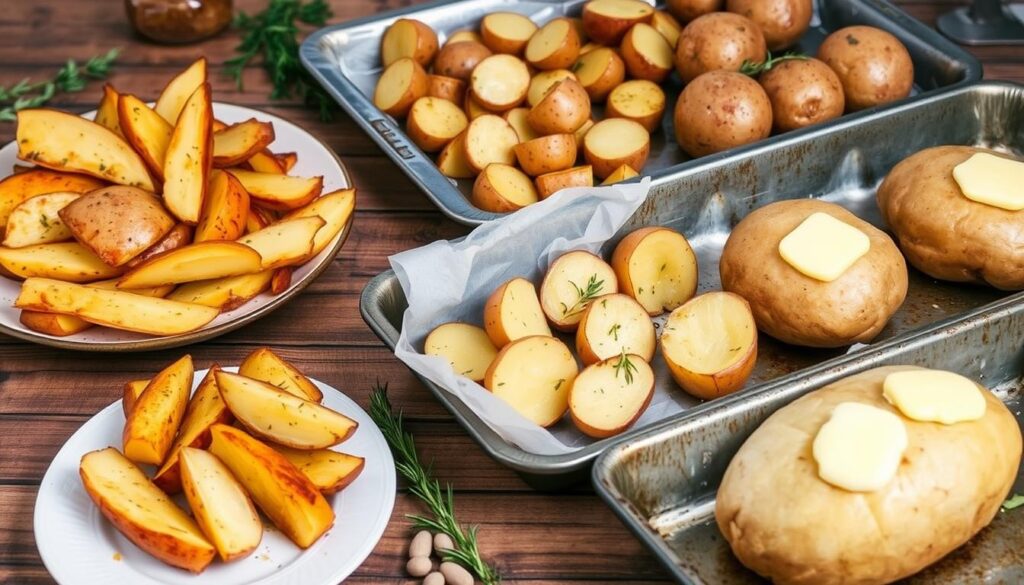The smell of a sizzling juicy ribeye fills the kitchen. It promises a steakhouse experience right at home. Tonight, you’ll make an ordinary evening special with a classic steak and potato dinner.
Imagine cutting into perfectly cooked baked russet potatoes and a tender steak. This creates a meal that’s both comforting and elegant. With just 30 minutes of prep and 20 minutes of cooking, you’ll make a dinner that’s like a restaurant’s.
Whether you’re new to cooking or experienced, this guide will help you. You’ll learn to make a delicious steak and potato meal. It’s all about flavor, nutrition, and technique. Get ready to improve your dinner game with expert tips and easy methods.
Understanding the Basics of a Great Steak and Potato Meal
To make a perfect meat and potatoes dinner, you need some cooking skills and planning. A tasty meal begins with picking top-notch ingredients that go well together.
When you’re cooking your grilled tenderloin, picking the right steak is key. Cuts like ribeye, sirloin, and New York strip are best for quick cooking. They bring out rich flavors and great textures, making your meal better.
Choosing the Right Cut of great steak and potato
- Ribeye: Marbled with fat for maximum flavor
- Sirloin: Leaner option with robust taste
- New York Strip: Balanced between tenderness and flavor
The Role of Potatoes in Your Meal: great steak and potato
A loaded baked potato is the ideal side for your steak. Try using Yukon Gold, red-skinned, or fingerling potatoes for different tastes and textures. Make a classic loaded baked potato with butter, cheese, and chives to go with your grilled tenderloin.
Pairing Sides and Sauces: great steak and potato
Make your meat and potatoes meal even better with the right sides and sauces. Add roasted veggies like Brussels sprouts or green beans for health benefits. Try garlic butter, Creole seasoning, or a classic pan sauce to enhance your dinner.
“The secret to a great steak and potato meal is in the details and quality of ingredients.” – Professional Chef
Essential Tools for Cooking Great Steak And Potato
To make perfect steakhouse dishes, you need more than just good ingredients. The right kitchen tools can make your prime rib or garlic mashed potatoes stand out. Choosing the right tools will help you get restaurant-quality results at home.
Must-Have Kitchen Equipment
Every home cook needs a few key tools for a great steak dinner:
- Sharp chef’s knife for precise cutting
- Meat thermometer for checking doneness
- Cast iron skillet for optimal heat distribution
- Potato masher or ricer for smooth garlic mashed potatoes
- Heavy-duty tongs for handling meat
Recommended Cookware: great steak and potato
Quality cookware can change your cooking game. A cast iron skillet is the best for searing steaks. It keeps heat well and cooks the steak evenly, making a perfect crust.
“The right pan can make all the difference between a good steak and a great one.”
Grilling vs. Pan-Searing: great steak and potato
Pan-searing and grilling both have their perks for cooking steak. Grilling adds a smoky taste, while pan-searing gives a crispy crust. Your choice depends on what you like and what you have.
- Grilling: Ideal for outdoor cooking and smoky flavor
- Pan-Searing: Perfect for creating a crisp, golden crust
Pro tip: Always let your steak rest at room temperature for 15-30 minutes before cooking. This ensures even heat.
Preparing Your Steak for Cooking: great steak and potato
Creating the ultimate meat and potatoes experience starts with a juicy ribeye. Proper steak preparation is key. It requires attention to detail and a few essential techniques.
Seasoning Techniques for Maximum Flavor: great steak and potato
Salt is your secret weapon for seasoning steaks. Use these tips to enhance your meat’s flavor:
- Select coarse kosher salt for better coverage
- Season generously 30-40 minutes before cooking
- Use freshly ground black pepper for additional depth
- Consider adding garlic powder for extra complexity
Marinating Magic: great steak and potato
High-quality cuts like New York strip don’t need long marinating. But a quick marinade can add depth to your steak’s flavor. Here’s a quick marinade recipe:
| Ingredient | Quantity |
|---|---|
| Worcestershire Sauce | 2 tablespoons |
| Dijon Mustard | 1 tablespoon |
| White Wine Vinegar | 1 teaspoon |
The Crucial Resting Period: great steak and potato
Resting your steak is a critical step often overlooked. After cooking, let your steak rest for 7-8 minutes. This allows juices to redistribute, ensuring a tender and flavorful eating experience.
“Patience is the secret ingredient in creating the perfect steak.” – Professional Chef
By following these preparation techniques, you’ll transform an ordinary piece of meat into a restaurant-quality dish. It celebrates the classic meat and potatoes tradition.
Cooking Techniques for great steak and potato
Learning to cook steak is all about mastering different techniques. These methods help bring out the best flavors in your prime rib or grilled tenderloin. To make a steakhouse-quality dish, you need precision and skill.
Grilling the Perfect Steak: great steak and potato
Grilling turns a simple steak into a work of art. Here are the essential steps:
- Choose steaks at least 1 inch thick
- Look for well-marbled cuts with white fat streaks
- Preheat grill to high temperature
- Cook for 3-4 minutes per side
Pan-Searing for a Juicy Finish
Pan-searing is the top choice for a restaurant-quality steak at home. Use a cast-iron or stainless steel pan that can handle high heat.
| Steak Cut | Recommended Cooking Time | Ideal Temperature |
|---|---|---|
| NY Strip | 3-4 minutes per side | 135°F (Medium-Rare) |
| Ribeye | 3-4 minutes per side | 145°F (Medium) |
| Filet Mignon | 2-3 minutes per side | 125°F (Rare) |
Oven Roasting for Even Cooking great steak and potato
For thicker steak cuts, finish cooking in a preheated oven. This method ensures even heat and prevents overcooking.
Pro tip: Always let your steak rest for 5-10 minutes after cooking. This allows juices to redistribute, making your steak more tender and flavorful.
Use an instant-read meat thermometer to check if your steak is done. Remember to cut your grilled tenderloin against the grain for extra tenderness.
Cooking Techniques for Potatoes
Potatoes can make your dinner special. Learning how to cook them can turn simple meals into amazing ones. You can make delicious baked russet potatoes, garlic mashed potatoes, and loaded baked potatoes that everyone will enjoy.
Boiling vs. Baking: Choosing the Right Method
There are many ways to cook potatoes. Boiling is great for creamy bases, while baking brings out deep flavors. Each method has its own benefits for your dish.
- Boiling: Quick and simple for soft potatoes
- Baking: Develops deeper flavor profiles
- Roasting: Creates crispy exterior textures
Perfecting Garlic Mashed Potatoes
To make creamy garlic mashed potatoes, start with good potatoes. Use a ricer for smoothness. Warm butter and milk add a rich texture that’s irresistible.
Roasting Potatoes for Extra Flavor
Roasting turns potatoes into crispy, flavorful treats. Cut them into even pieces, toss with oil and spices, and roast at 400°F for 20-25 minutes. Halfway through, stir to get even browning.
“The secret to great potatoes is understanding their unique cooking characteristics.” – Culinary Expert
| Potato Cooking Method | Temperature | Cooking Time | Best For |
|---|---|---|---|
| Boiling | 212°F | 10-15 minutes | Mashed potatoes |
| Baking | 425°F | 45-60 minutes | Baked russet potatoes |
| Roasting | 400°F | 20-25 minutes | Crispy potato chunks |
With these tips, you’ll make potato dishes that wow your loved ones. Try different methods to find your favorite!
Choosing the Right Potatoes
Choosing the perfect potato can make your baked russet potatoes amazing. Knowing about different potatoes helps you make the best loaded baked potato. This pairs well with your favorite meat dishes.
There are about 4,000 potato varieties worldwide. Each variety adds something special to your meal. So, picking the right potato is key for great cooking.
Types of Potatoes for Different Dishes
- Russet Potatoes: High-starch variety perfect for fluffy baked potatoes
- Yukon Gold: Medium-starch potatoes ideal for versatile cooking
- Red Bliss: Waxy potatoes great for maintaining shape in salads
- Fingerling: Small, elongated potatoes with distinctive flavor
Waxy vs. Starchy Potatoes: When to Use Each
| Potato Type | Starch Content | Best Uses |
|---|---|---|
| High-Starch (Russet) | High | Baking, mashing, roasting |
| Medium-Starch (Yukon Gold) | Medium | Roasting, mashing, all-purpose cooking |
| Low-Starch (Red Bliss) | Low | Potato salads, boiling, maintaining shape |
Organic vs. Conventional Potatoes
Choosing between organic and conventional potatoes is also important. Organic potatoes might have fewer pesticides. But, conventional potatoes are safe and cheaper. Both are good sources of potassium, vitamin C, and iron.
“The right potato can elevate your meat and potatoes dinner from good to unforgettable.” – Culinary Expert
Pro tip: Keep your potatoes in a cool, dark place. This helps them stay fresh and prevents them from sprouting.
Pairing Jus with great steak and potato
Improving your steakhouse meal is more than just cooking a perfect prime rib. The right jus can turn a good steak and potato dinner into a memorable experience. Learning how to make and pair the perfect sauce is key to a great home-cooked meal.
Crafting the Perfect Jus
Making a tasty jus is easier than you think. Begin by deglazing your pan with beef broth, catching all the flavorful bits from searing your steak. Then, reduce the liquid to intensify the flavors, making a sauce that perfectly complements your prime rib.
Lemon-Infused Options
- Add a fresh squeeze of lemon to brighten the jus
- Serve lemon wedges on the side for guests to customize
- Use citrus zest to add a subtle, tangy note
Non-Alcoholic Beverage Pairings
Boost your steakhouse experience with these refreshing drinks:
- Sparkling water with citrus
- Iced tea with a hint of mint
- Virgin bloody mary for a classic steakhouse feel
“The right sauce can elevate a good steak to an extraordinary dining experience.”
The secret to a perfect jus is balance. You want a sauce that enhances your steak and potato dinner without overwhelming the meat’s natural taste. Try different methods and find what you like best.
Creating Flavorful Side Dishes
Making the perfect sides for your steak dinner can turn it into something special. Side dishes are more than just extras. They’re key to making your meal unforgettable.
Fresh Salad Ideas
A fresh salad can make your surf and turf meal pop with flavor and texture. Here are some tasty options:
- Caesar Salad: Romaine lettuce with creamy dressing and Parmesan
- Mixed Green Salad with cherry tomatoes and light vinaigrette
- Arugula salad with shaved Parmesan and lemon dressing
Vegetable Accompaniments
Vegetables add nutrition and color to your steak dinner. Try these delicious choices:
- Roasted Asparagus with olive oil and garlic
- Sautéed Mushrooms in butter and herbs
- Green Beans Almondine with toasted sliced almonds
- Creamed Spinach for a luxurious touch
Bread and Butter Pairings
No steakhouse meal is complete without warm, crusty bread. Add flavor with herb-infused butter or compound spreads that match your main dish.
“The right side dish can transform a good meal into an unforgettable dining experience.” – Culinary Expert
When picking side dishes, aim for balance. Mix textures, flavors, and colors that bring out the best in your steak without overpowering it.
Tips for Plating Your Meal
Presenting a great steak and potato dinner is an art form. It turns an ordinary meal into a special experience. The way your dish looks is just as important as how it tastes.
Presentation Techniques
When plating your loaded baked potato and steak, keep these tips in mind:
- Cut steak against the grain to show off tender fibers
- Use white plates to make colors stand out
- Leave some space for visual breathing room
- Strive for symmetry and balance
Garnishing for Impact
Make your plate stunning with the right garnishes:
- Sprinkle fresh herbs like parsley or thyme
- Add a pat of herb butter on steak
- Use microgreens for height and texture
- Drizzle rich au jus around the protein
Balancing Colors on the Plate
Make your meal look good by balancing colors and textures:
| Color | Side Suggestion | Visual Impact |
|---|---|---|
| Green | Asparagus | Freshness |
| Orange | Baby Carrots | Warmth |
| Red | Roasted Tomatoes | Vibrancy |
“Plating is the first bite with the eyes.” – Professional Chef
Your goal is to make a plate that looks as good as it tastes. Try different techniques and find your own style. This will make your steak and potato meal unforgettable.
Enjoying Your Great Steak and Potato Dinner
To make a memorable steakhouse meal at home, it’s not just about the food. The atmosphere you create is key. Dim the lights, use crisp napkins, and turn your kitchen into a cozy spot for meat and potatoes.
Setting the Mood for Dinner
Choose top-notch steak knives to match your dish. A nice table setting shows your meal is special. Soft music in the background helps conversation flow without being too loud. You want to make the space welcoming and fun for every bite.
Tips for a Great Dining Experience
Turn off phones and tablets to focus on each other. Talk about your cooking and the steak and potatoes you made. Every moment at the table is a chance to bond and enjoy your homemade meal.
Sharing the Meal with Family and Friends
Get your loved ones involved in cooking or serve the meal family-style. This makes dinner a special event. Enjoy the flavors of your steak and potatoes together, making the evening unforgettable.
FAQ
What are the best cuts of steak for a quick dinner?
For a fast dinner, pick tender cuts like sirloin, beef tenderloin, or New York strip steak. They cook quickly and taste great. They’re perfect for busy nights and can be ready in under 20 minutes.
How do I know when my steak is cooked to the right temperature?
Use a meat thermometer to check the steak’s doneness. For medium-rare, aim for 130-140°F. Medium is 140-150°F. Always let your steak rest for 5-10 minutes after cooking. This helps keep juices in and ensures the best flavor and texture.
Which potatoes work best for different cooking methods?
Yukon Gold potatoes are great for a balance of starch and waxiness. Russet potatoes are best for fluffy mashed potatoes or crispy roasted versions. Waxy potatoes like red or fingerling varieties are perfect for salads and roasted dishes because they hold their shape well.
What’s the best way to cook steak – grilling or pan-searing?
Both grilling and pan-searing are excellent methods. Grilling gives a smoky flavor, cooking for 2-3 minutes per side. Pan-searing in a cast iron skillet creates a caramelized crust, cooking 3-4 minutes per side. For thick cuts, finish in a 400°F oven to ensure even cooking.
How can I add more flavor to my steak and potatoes?
Season generously with salt, pepper, and garlic powder. Try different seasoning blends like Creole, ranch, or Italian. Create a simple jus by deglazing the pan with beef broth. Add a pat of herb-infused butter or garnish with fresh herbs like parsley or thyme.
What are some good side dishes to serve with steak and potatoes?
Consider roasted vegetables like Brussels sprouts or asparagus. Prepare a crisp salad with mixed greens and cherry tomatoes. Sautéed mushrooms complement steak perfectly. Serve warm, crusty bread with herb-infused butter for a complete steakhouse-style meal.
Are organic potatoes worth buying?
Organic potatoes may have fewer pesticides, but conventional potatoes are safe and often more affordable. The choice depends on your personal preferences, budget, and health considerations. Both types can be delicious when prepared correctly.
What non-alcoholic drinks pair well with steak and potatoes?
Try sparkling water with citrus, iced tea, or a virgin bloody mary for a steakhouse feel. These options complement the rich flavors of steak and potatoes without overpowering the meal’s nuanced tastes.

